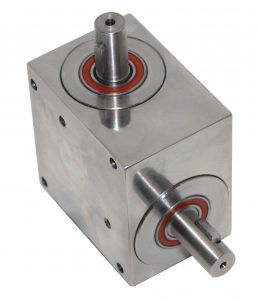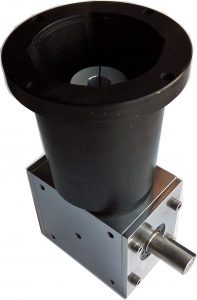Rototime News: White Page 2016
Electropolishing Gearbox Benefits Machine Elegance and Meets FDA Food Safety Standards
Properly made gearbox will not shelter bacteria, but an Electropolished Stainless Steel gearbox will provide the most forward thinking and practical solution for any industry.
Electropolishing: The electrochemical removal of metal impurities (carbon, silica, and free iron) from a stainless steel surface. The goal is a smooth surface, devoid of burrs or crevices that attract and trap contaminants (mirror finish). Electropolishing process removes only a very thin surface layer (typically between 0.001″ and 0.0001Prior to electropolishing, parts are mechanically prepared to ensure optimal results. All welds are ground, deburred, and inspected to ensure that all seams are free of pockets or gaps. Finally, selected surfaces are mechanically buffed to a smooth finish. Next, the part is fitted with electrodes, immersed in an electrolyte solution, and subjected to a direct electrical current. During this electrolytic process, the metallic surface of the anodic part (in this case, stainless steel) is preferentially dissolved ion by ion, yielding a nickel- and chromium-rich surface that protects against metal fatigue or contamination. Optimal results depend on careful control over the current density, the precise chemical composition of the electrolytic solution, the temperature and agitation of the bath, and the duration of current exposure. Unlike mechanically finished stainless steel, electropolished surfaces feature no fine directional lines and hence offer less friction and surface drag.
The chromium-rich surface results in excellent light reflection, yielding a bright, smooth and uniform polish.
Stainless Steel: The. 316 stainless steel is a “cleaner†grade of steel. A solid block is much harder to machine because some area will have hard spots. To prevent tool break and ease machine operation the solid block should be anneal. Annealing soften the metal.ÂSteel is an iron metal alloy containing other elements that typically include manganese, nickel, chromium, molybdenum, carbon, and silicon. Stainless steel contains a minimum of 50% iron. Some of these other elements influence the hardness and formability of the steel (carbon and silicon, for example), while others have an effect on corrosion resistance (such as chromium).The amount of chromium present differentiates “regular†steel from “stainless†steel. Chromium that is exposed to oxygen forms a strongly-bonded film of chromium oxide on the stainless steel, blocking the oxygen from damaging the surface, as well as infiltrating the internal structure. Electropolishing increases the surface chromium, thereby promoting formation of this protective film. Non-stainless-steel, with lower levels of chromium, will eventually rust when exposed to moisture and air.
Material Selection: Electropolishing is performed on 304 or 316 stainless steel ( mirror finish) that has either a 2B or 4 mill finish. Also, can be done on 416. ÂIncoming material is also inspected for improper annealing (a heat treatment to increase ductility), over-pickling (chemical treatment to remove oxidation), heat scale, and directional roll marks, all of which are accentuated by electropolishing.Stainless steel parts intended for electropolishing are designed with smooth welds, free of pits, gaps, and scratched.









